tow bar TOYOTA SEQUOIA HYBRID 2023 Owners Manual
[x] Cancel search | Manufacturer: TOYOTA, Model Year: 2023, Model line: SEQUOIA HYBRID, Model: TOYOTA SEQUOIA HYBRID 2023Pages: 628, PDF Size: 14.27 MB
Page 3 of 628
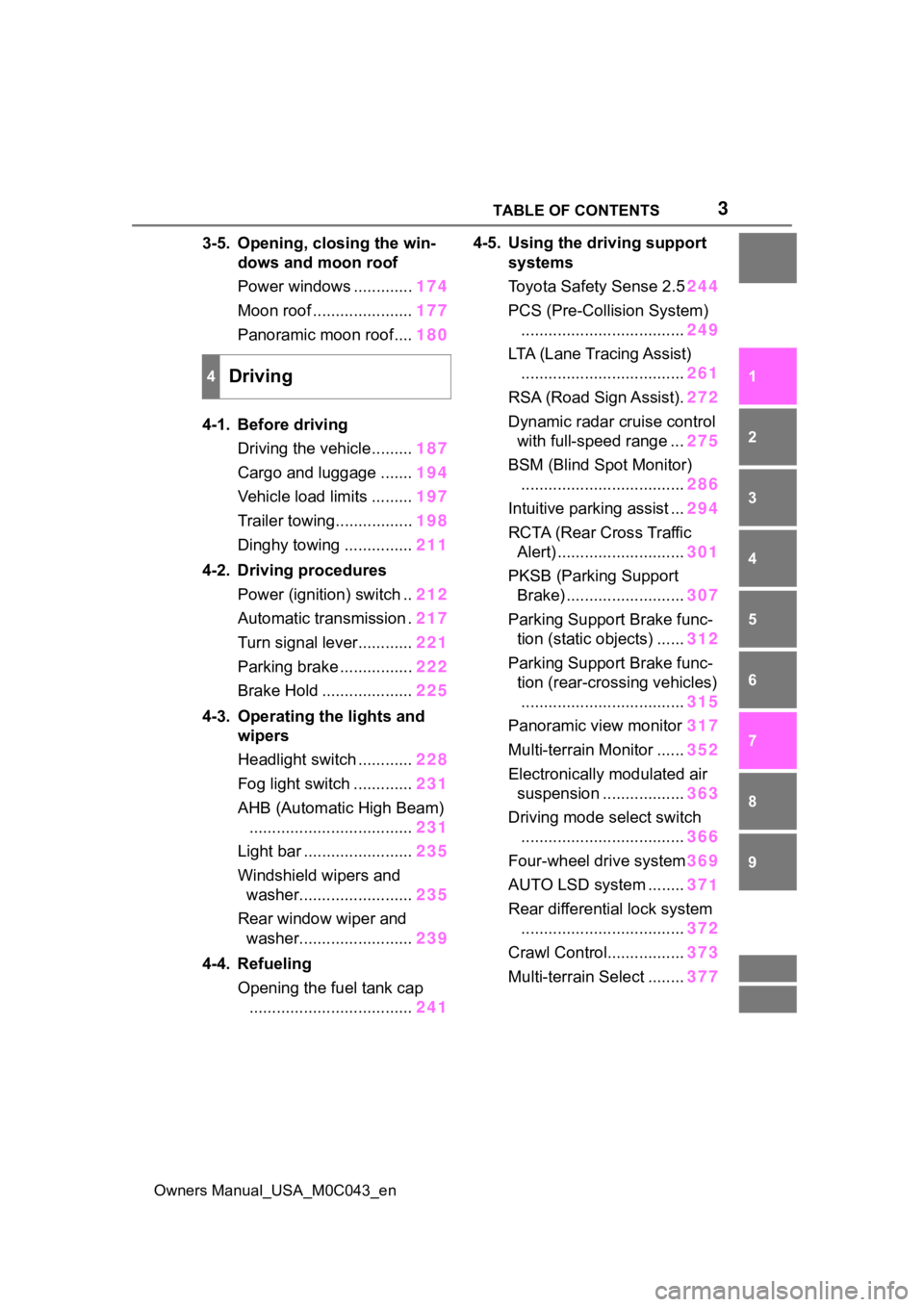
3TABLE OF CONTENTS
Owners Manual_USA_M0C043_en
1
2
3
4
5
6
7
8
9
3-5. Opening, closing the win- dows and moon roof
Power windows ............. 174
Moon roof ...................... 177
Panoramic moon roof.... 180
4-1. Before driving Driving the vehicle......... 187
Cargo and luggage ....... 194
Vehicle load limits ......... 197
Trailer towing................. 198
Dinghy towing ............... 211
4-2. Driving procedures Power (ignition) switch .. 212
Automatic transmission . 217
Turn signal lever............ 221
Parking brake ................ 222
Brake Hold .................... 225
4-3. Operating the lights and wipers
Headlight switch ............ 228
Fog light switch ............. 231
AHB (Automatic High Beam) .................................... 231
Light bar ........................ 235
Windshield wipers and washer......................... 235
Rear window wiper and washer......................... 239
4-4. Refueling Opening the fuel tank cap.................................... 2414-5. Using the driving support
systems
Toyota Safet y Sense 2.5244
PCS (Pre-Collision System) .................................... 249
LTA (Lane Tracing Assist) .................................... 261
RSA (Road Sign Assist). 272
Dynamic radar cruise control with full-speed range ... 275
BSM (Blind Spot Monitor) .................................... 286
Intuitive parking assist ... 294
RCTA (Rear Cross Traffic Alert) ............................ 301
PKSB (Parking Support Brake) .......................... 307
Parking Support Brake func- tion (static objects) ...... 312
Parking Support Brake func- tion (rear-crossing vehicles)
.................................... 315
Panoramic view monitor 317
Multi-terrain Monitor ...... 352
Electronically modulated air suspension .................. 363
Driving mode s elect switch
.................................... 366
Four-wheel drive system 369
AUTO LSD system ........ 37
1
Re ar dif
ferential lock system
.................................... 372
Crawl Control................. 373
Multi-terrain Select ........ 377
4Driving
Page 20 of 628
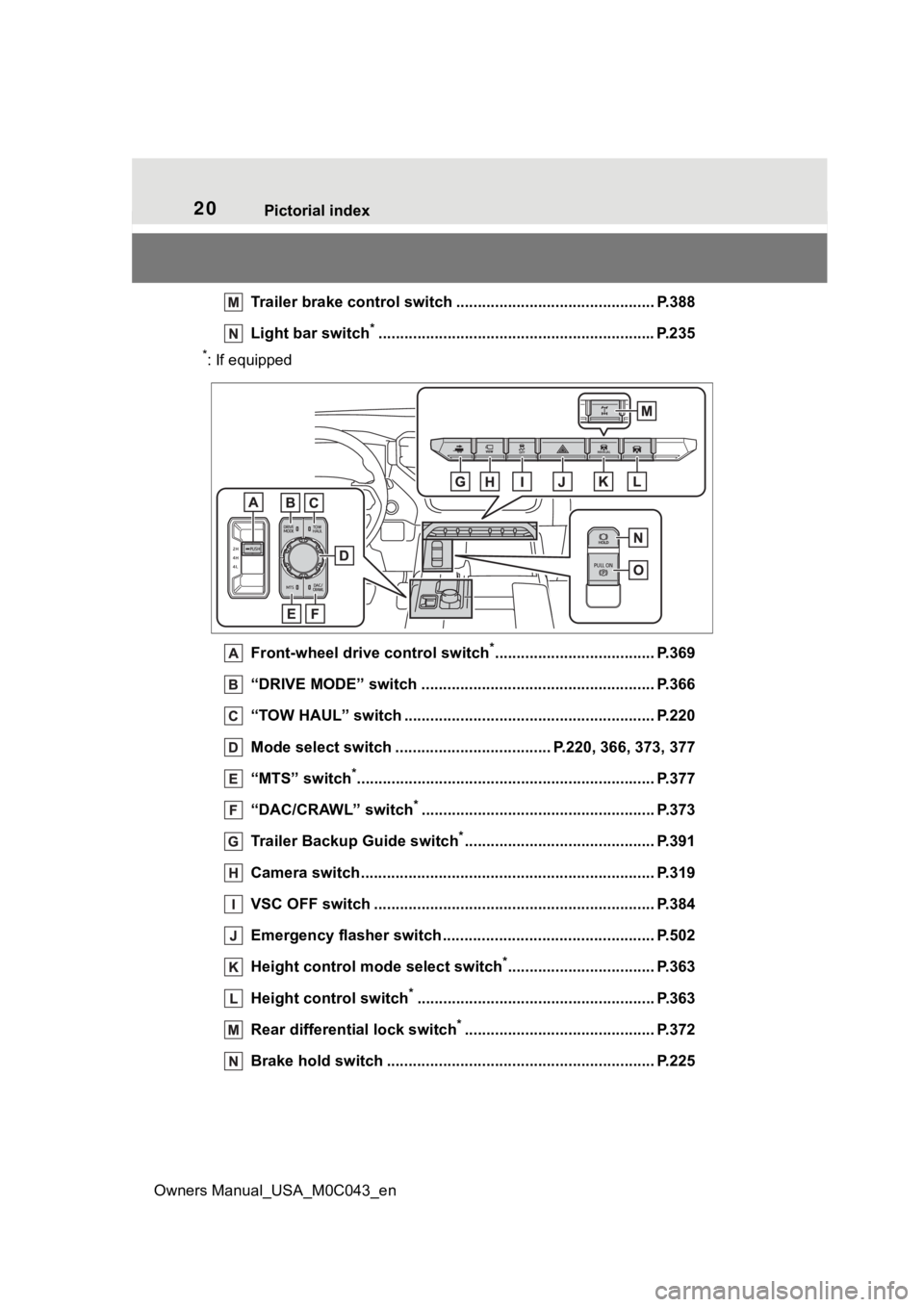
20Pictorial index
Owners Manual_USA_M0C043_en
Trailer brake control switc h .............................................. P.388
Light bar switch
*............................................................... .P.235
*: If equipped
Front-wheel drive control switch
*..................................... P.369
“DRIVE MODE” switch ...................................................... P.366
“TOW HAUL” switch .............................................. ............ P.220
Mode select switch .................................... P.220, 36 6, 373, 377
“MTS” switch
*............................................................... ...... P.377
“DAC/CRAWL” switch
*...................................................... P.373
Trailer Backup Guide switch
*............................................ P.391
Camera switch .................................................. .................. P.319
VSC OFF switch ................................................. ................ P.384
Emergency flasher switch ....................................... .......... P.502
Height control mode select switch
*.................................. P.363
Height control switch
*....................................................... P.363
Rear differential lock switch
*............................................ P.372
Brake hold switch .............................................. ................ P.225
Page 185 of 628
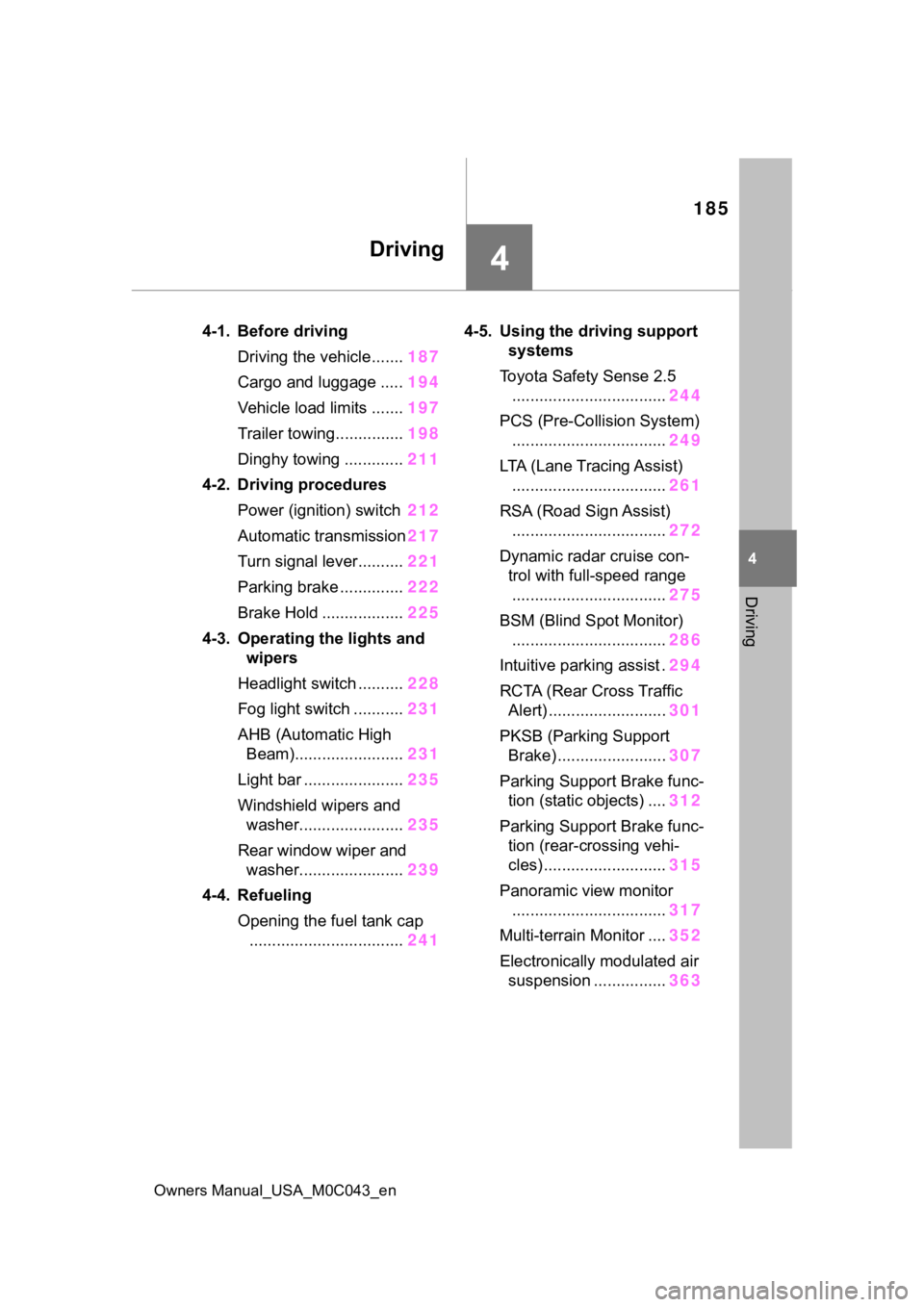
185
Owners Manual_USA_M0C043_en
4
4
Driving
Driving
4-1. Before drivingDriving the vehicle....... 187
Cargo and luggage ..... 194
Vehicle load limits ....... 197
Trailer towing............... 198
Dinghy towing ............. 211
4-2. Driving procedures Power (ignition) switch 212
Automatic transmission 217
Turn signal lever.......... 221
Parking brake .............. 222
Brake Hold .................. 225
4-3. Operating the lights and wipers
Headlight switch .......... 228
Fog light switch ........... 231
AHB (Automatic High Beam)........................ 231
Light bar ...................... 235
Windshield wipers and washer....................... 235
Rear window wiper and washer....................... 239
4-4. Refueling Opening the fuel tank cap.................................. 2414-5. Using the dr
iving support
systems
Toyota Safety Sense 2.5 .................................. 244
PCS (Pre-Collision System) .................................. 249
LTA (Lane Tracing Assist) .................................. 261
RSA (Road Sign Assist) .................................. 272
Dynamic radar cruise con- trol with full-speed range
.................................. 275
BSM (Blind Spot Monitor) .................................. 286
Intuitive parking assist . 294
RCTA (Rear Cross Traffic Alert) .......................... 301
PKSB (Parking Support Brake) ........................ 307
Parking Support Brake func- tion (static objects) .... 312
Parking Support Brake func- tion (rear-crossing vehi-
cles) ........................... 315
Panoramic view monitor .................................. 317
Multi-terrain Monitor .... 352
Electronically modulated air suspension ................ 363
Page 197 of 628
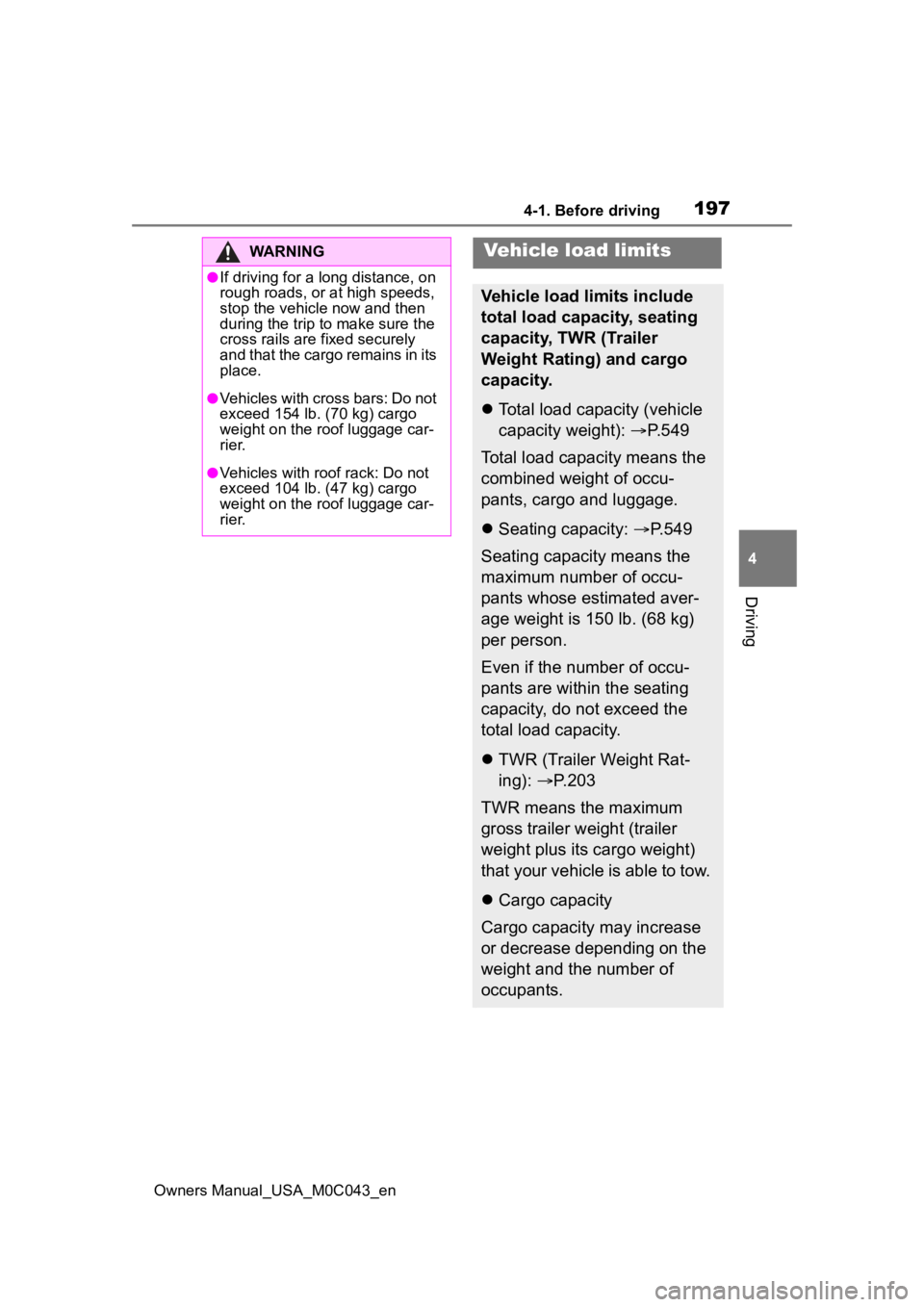
1974-1. Before driving
Owners Manual_USA_M0C043_en
4
Driving
WARNING
●If driving for a long distance, on
rough roads, or at high speeds,
stop the vehicle now and then
during the trip to make sure the
cross rails are fixed securely
and that the cargo remains in its
place.
●Vehicles with cross bars: Do not
exceed 154 lb. (70 kg) cargo
weight on the roof luggage car-
rier.
●Vehicles with roof rack: Do not
exceed 104 lb. (47 kg) cargo
weight on the roof luggage car-
rier.
Vehicle load limits
Vehicle load limits include
total load capacity, seating
capacity, TWR (Trailer
Weight Rating) and cargo
capacity.
Total load capacity (vehicle
capacity weight): P.549
Total load capacity means the
combined weight of occu-
pants, cargo and luggage.
Seating capacity: P.549
Seating capacity means the
maximum number of occu-
pants whose estimated aver-
age weight is 150 lb. (68 kg)
per person.
Even if the number of occu-
pants are within the seating
capacity, do not exceed the
total load capacity.
TWR (Trailer Weight Rat-
ing): P.203
TWR means the maximum
gross trailer weight (trailer
weight plus its cargo weight)
that your vehicle is able to tow.
Cargo capacity
Cargo capacity may increase
or decrease depending on the
weight and the number of
occupants.
Page 257 of 628
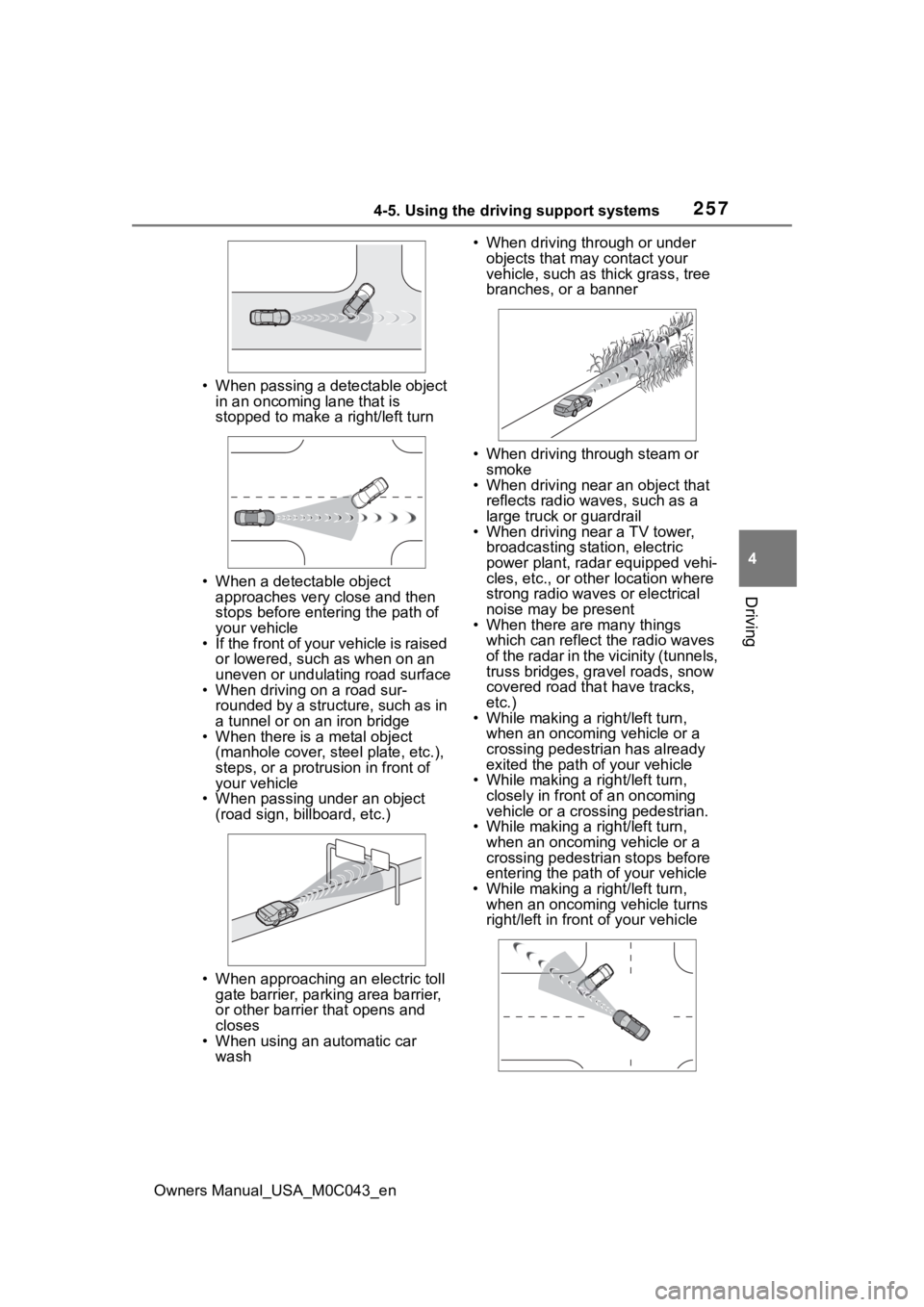
2574-5. Using the driving support systems
Owners Manual_USA_M0C043_en
4
Driving
• When passing a detectable object in an oncoming lane that is
stopped to make a right/left turn
• When a detectable object approaches very close and then
stops before entering the path of
your vehicle
• If the front of your vehicle is raised
or lowered, such as when on an
uneven or undulating road surface
• When driving on a road sur-
rounded by a structure, such as in
a tunnel or on an iron bridge
• When there is a metal object
(manhole cover, steel plate, etc.),
steps, or a protrusion in front of
your vehicle
• When passing under an object (road sign, billboard, etc.)
• When approaching an electric toll gate barrier, parking area barrier,
or other barrier that opens and
closes
• When using an automatic car wash • When driving through or under
objects that may contact your
vehicle, such as thick grass, tree
branches, or a banner
• When driving through steam or smoke
• When driving near an object that reflects radio waves, such as a
large truck or guardrail
• When driving near a TV tower, broadcasting station, electric
power plant, radar equipped vehi-
cles, etc., or other location where
strong radio waves or electrical
noise may be present
• When there are many things which can reflect the radio waves
of the radar in the vicinity (tunnels,
truss bridges, gravel roads, snow
covered road that have tracks,
etc.)
• While making a right/left turn,
when an oncoming vehicle or a
crossing pedestrian has already
exited the path of your vehicle
• While making a right/left turn,
closely in front of an oncoming
vehicle or a crossing pedestrian.
• While making a right/left turn,
when an oncoming vehicle or a
crossing pedestrian stops before
entering the path of your vehicle
• While making a right/left turn,
when an oncoming vehicle turns
right/left in fron t of your vehicle
Page 262 of 628
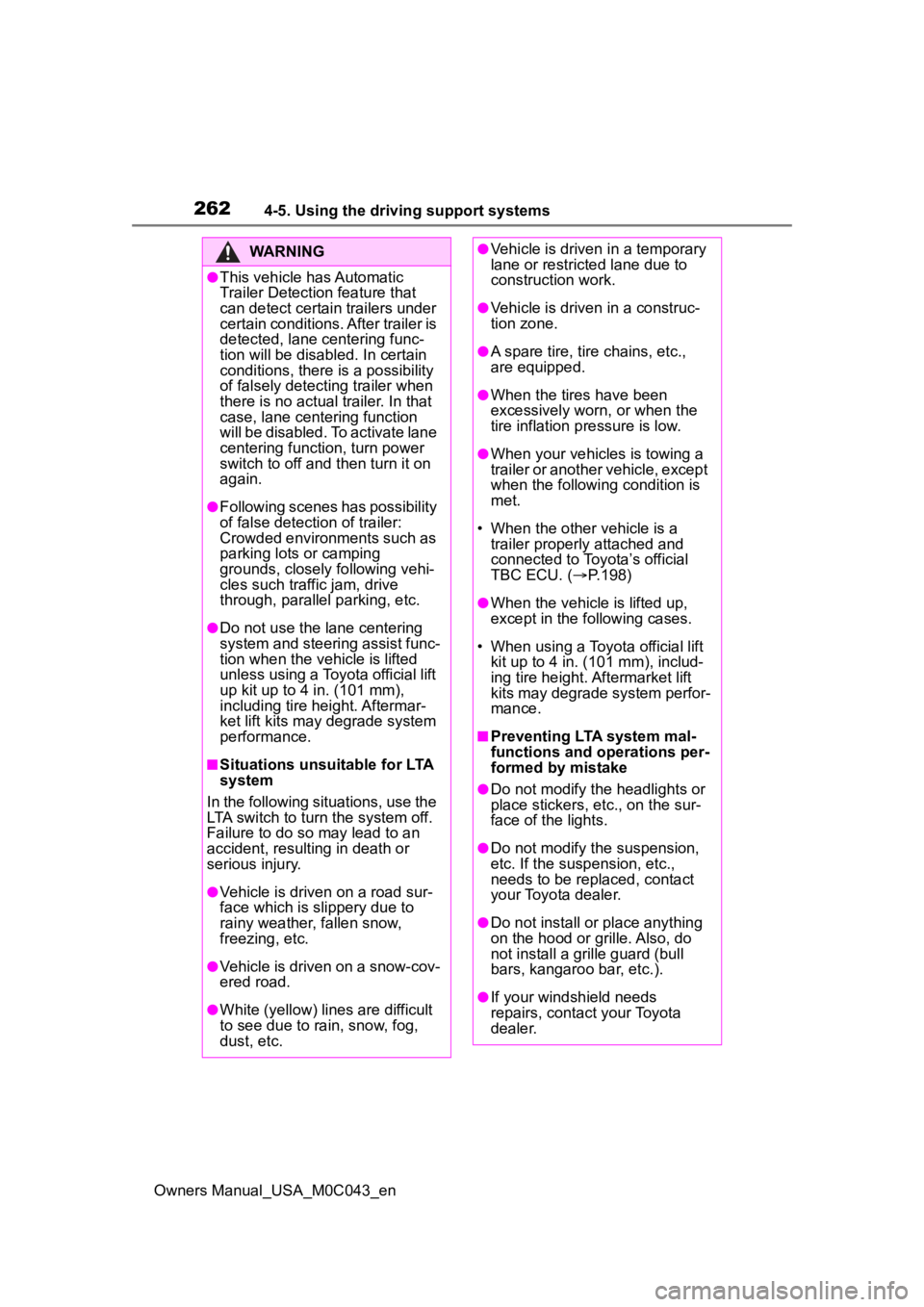
2624-5. Using the driving support systems
Owners Manual_USA_M0C043_en
WARNING
●This vehicle has Automatic
Trailer Detection feature that
can detect certain trailers under
certain conditions. After trailer is
detected, lane centering func-
tion will be disabled. In certain
conditions, there is a possibility
of falsely detecting trailer when
there is no actual trailer. In that
case, lane centering function
will be disabled. To activate lane
centering function, turn power
switch to off and then turn it on
again.
●Following scenes has possibility
of false detection of trailer:
Crowded environments such as
parking lots or camping
grounds, closely following vehi-
cles such traffic jam, drive
through, parallel parking, etc.
●Do not use the lane centering
system and steering assist func-
tion when the vehicle is lifted
unless using a Toyota official lift
up kit up to 4 in. (101 mm),
including tire height. Aftermar-
ket lift kits may degrade system
performance.
■Situations unsuitable for LTA
system
In the following situations, use the
LTA switch to turn the system off.
Failure to do so may lead to an
accident, resulting in death or
serious injury.
●Vehicle is driven on a road sur-
face which is slippery due to
rainy weather, fallen snow,
freezing, etc.
●Vehicle is driven on a snow-cov-
ered road.
●White (yellow) lines are difficult
to see due to rain, snow, fog,
dust, etc.
●Vehicle is driven in a temporary
lane or restricted lane due to
construction work.
●Vehicle is driven in a construc-
tion zone.
●A spare tire, tire chains, etc.,
are equipped.
●When the tires have been
excessively worn, or when the
tire inflation p ressure is low.
●When your vehicles is towing a
trailer or another vehicle, except
when the followin g condition is
met.
• When the other vehicle is a trailer properly attached and
connected to Toyota’s official
TBC ECU. ( P.198)
●When the vehicle is lifted up,
except in the following cases.
• When using a Toyota official lift kit up to 4 in. (101 mm), includ-
ing tire height. Aftermarket lift
kits may degrade system perfor-
mance.
■Preventing LTA system mal-
functions and operations per-
formed by mistake
●Do not modify the headlights or
place stickers, etc., on the sur-
face of the lights.
●Do not modify the suspension,
etc. If the suspension, etc.,
needs to be replaced, contact
your Toyota dealer.
●Do not install or place anything
on the hood or grille. Also, do
not install a gr ille guard (bull
bars, kangaroo bar, etc.).
●If your windshield needs
repairs, contact your Toyota
dealer.
Page 298 of 628
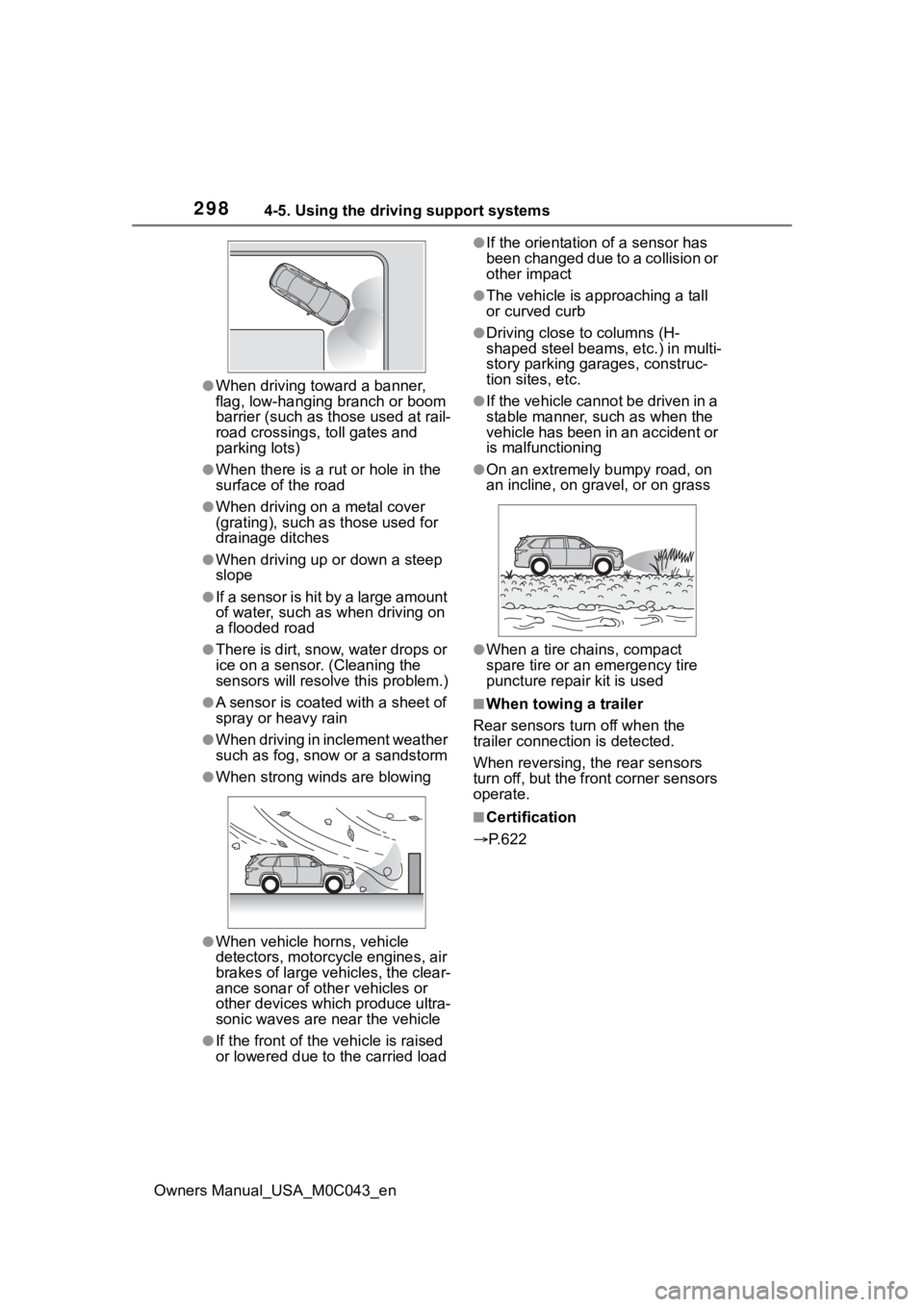
2984-5. Using the driving support systems
Owners Manual_USA_M0C043_en
●When driving toward a banner,
flag, low-hanging branch or boom
barrier (such as those used at rail-
road crossings, toll gates and
parking lots)
●When there is a rut or hole in the
surface of the road
●When driving on a metal cover
(grating), such as those used for
drainage ditches
●When driving up or down a steep
slope
●If a sensor is hit by a large amount
of water, such as when driving on
a flooded road
●There is dirt, snow, water drops or
ice on a sensor. (Cleaning the
sensors will resolve this problem.)
●A sensor is coated with a sheet of
spray or heavy rain
●When driving in inclement weather
such as fog, snow or a sandstorm
●When strong winds are blowing
●When vehicle horns, vehicle
detectors, motorcycle engines, air
brakes of large vehicles, the clear-
ance sonar of other vehicles or
other devices which produce ultra-
sonic waves are near the vehicle
●If the front of the vehicle is raised
or lowered due to the carried load
●If the orientation of a sensor has
been changed due to a collision or
other impact
●The vehicle is approaching a tall
or curved curb
●Driving close to columns (H-
shaped steel beams, etc.) in multi-
story parking garages, construc-
tion sites, etc.
●If the vehicle cannot be driven in a
stable manner, such as when the
vehicle has been in an accident or
is malfunctioning
●On an extremely bumpy road, on
an incline, on gravel, or on grass
●When a tire chains, compact
spare tire or an emergency tire
puncture repair kit is used
■When towing a trailer
Rear sensors turn off when the
trailer connection is detected.
When reversing, the rear sensors
turn off, but the front corner sensors
operate.
■Certification
P.622
Page 555 of 628
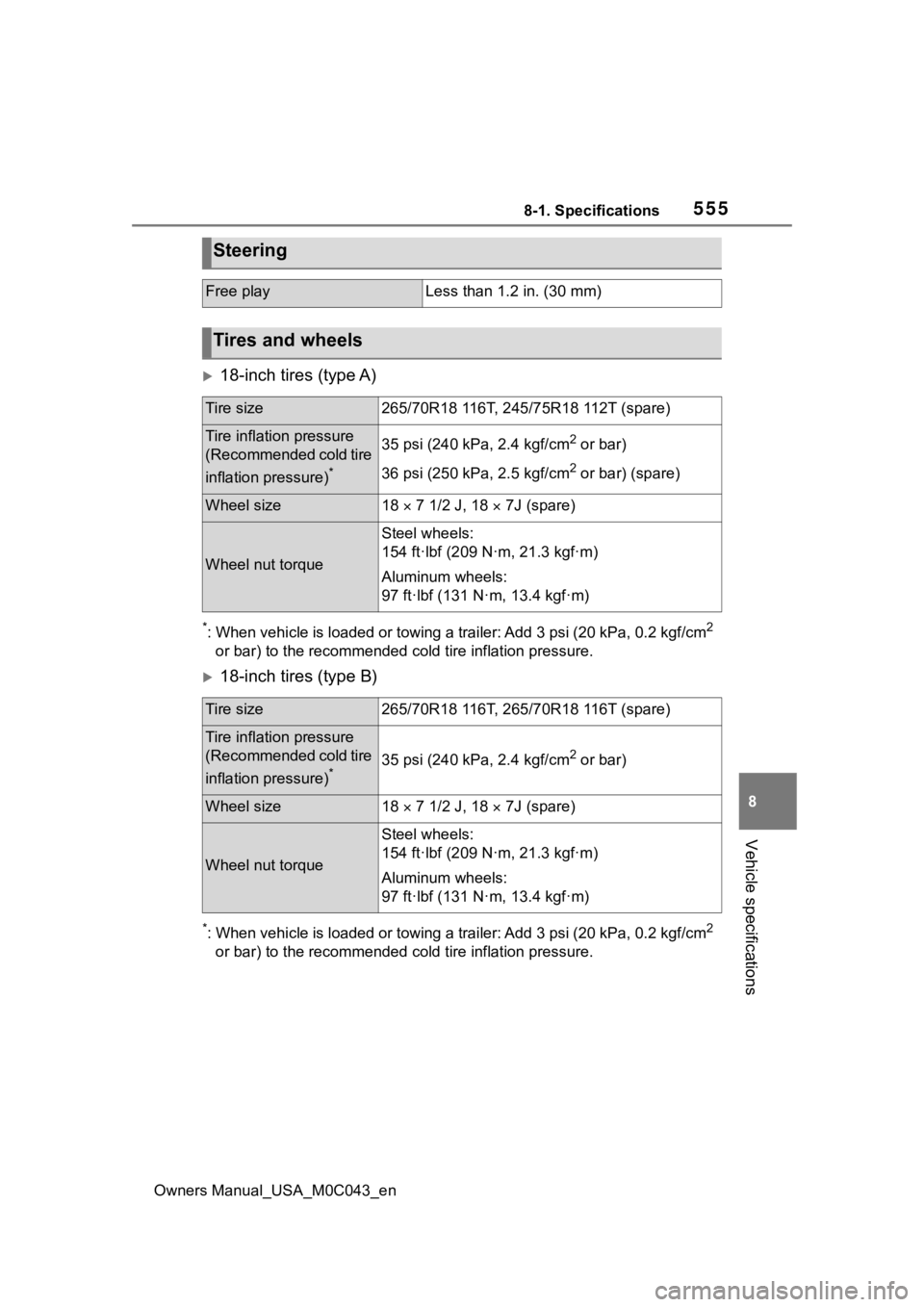
5558-1. Specifications
Owners Manual_USA_M0C043_en
8
Vehicle specifications
18-inch tires (type A)
*: When vehicle is loaded or towing a trailer: Add 3 psi (20 kPa, 0.2 kgf/cm2
or bar) to the recommended cold tire inflation pressure.
18-inch tires (type B)
*: When vehicle is loaded or towing a trailer: Add 3 psi (20 kPa, 0.2 kgf/cm2
or bar) to the recommended cold tire inflation pressure.
Steering
Free playLess than 1.2 in. (30 mm)
Tires and wheels
Tire size265/70R18 116T, 245/75R18 112T (spare)
Tire inflation pressure
(Recommended cold tire
inflation pressure)
*
35 psi (240 kPa, 2.4 kgf/cm2 or bar)
36 psi (250 kPa, 2.5 kgf/cm
2 or bar) (spare)
Wheel size18 7 1/2 J, 18 7J (spare)
Wheel nut torque
Steel wheels:
154 ft·lbf (209 N·m, 21.3 kgf·m)
Aluminum wheels:
97 ft·lbf (131 N·m, 13.4 kgf·m)
Tire size265/70R18 116T, 265/70R18 116T (spare)
Tire inflation pressure
(Recommended cold tire
inflation pressure)
*35 psi (240 kPa, 2.4 kgf/cm2 or bar)
Wheel size18 7 1/2 J, 18 7J (spare)
Wheel nut torque
Steel wheels:
154 ft·lbf (209 N·m, 21.3 kgf·m)
Aluminum wheels:
97 ft·lbf (131 N·m, 13.4 kgf·m)
Page 556 of 628

5568-1. Specifications
Owners Manual_USA_M0C043_en
18-inch tires (type C)
*: When vehicle is loaded or towing a trailer: Add 3 psi (20 kPa, 0.2 kgf/cm2
or bar) to the recommended cold tire inflation pressure.
20-inch tires
*: When vehicle is loaded or towing a trailer: Add 3 psi (20 kPa, 0.2 kgf/cm2
or bar) to the recommended cold tire inflation pressure.
22-inch tires
Tire size285/65R18 116T, 265/70R18 116T (spare)
Tire inflation pressure
(Recommended cold tire
inflation pressure)
*35 psi (240 kPa, 2.4 kgf/cm2 or bar)
Wheel size18 8 1/2 J, 18 7J (spare)
Wheel nut torque
Steel wheels:
154 ft·lbf (209 N·m, 21.3 kgf·m)
Aluminum wheels:
97 ft·lbf (131 N·m, 13.4 kgf·m)
Tire size265/60R20 112H, 245/75R18 112T (spare)
Tire inflation pressure
(Recommended cold tire
inflation pressure)
*36 psi (250 kPa, 2.5 kgf/cm2 or bar)
Wheel size20 8J, 18 7J (spare)
Wheel nut torque
Steel wheels:
154 ft·lbf (209 N·m, 21.3 kgf·m)
Aluminum wheels:
97 ft·lbf (131 N·m, 13.4 kgf·m)
Tire size265/50R22 112H, 245/75R18 112T (spare)
Tire inflation pressure
(Recommended cold tire
inflation pressure)
Front:
38 psi (260 kPa, 2.6 kgf/cm
2 or bar)
Rear:
42 psi (290 kPa, 2.9 kgf/cm
2 or bar)
Spare:
36 psi (250 kPa, 2.5 kgf/cm
2 or bar)